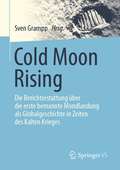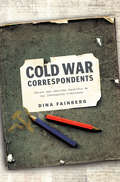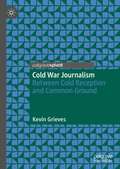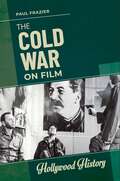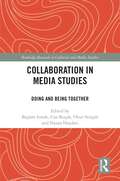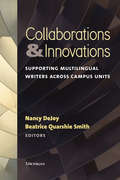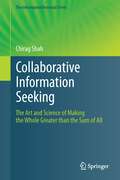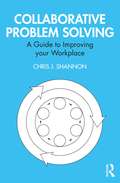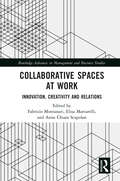- Table View
- List View
Cognitive Wireless Networks (SpringerBriefs in Electrical and Computer Engineering)
by Zhiyong Feng Qixun Zhang Ping ZhangThis brief examines the current research in cognitive wireless networks (CWNs). Along with a review of challenges in CWNs, this brief presents novel theoretical studies and architecture models for CWNs, advances in the cognitive information awareness and delivery, and intelligent resource management technologies. The brief presents the motivations and concepts of CWNs, including theoretical studies of temporal and geographic distribution entropy as well as cognitive information metrics. A new architecture model of CWNs is proposed with theoretical, functional and deployment architectures supporting cognitive information flow and resource flow. Key technologies are identified to achieve the efficient cognitive information awareness and delivery. The brief concludes by validating the effectiveness of proposed theories and technologies using the CWNs testbed and discussing the importance of standardization practices. The context and analysis provided by this text are ideal for researchers and practitioners interested in wireless networks and cognitive information. Cognitive Wireless Networks is also valuable for advanced-level students studying resource management and networking.
Cognitive Wireless Networks: Concepts, Methodologies and Visions Inspiring the Age of Enlightenment of Wireless Communications
by Frank H. P. Fitzek Marcos D. KatzThis book advocates the idea of breaking up the cellular communication architecture by introducing cooperative strategies among wireless devices through cognitive wireless networking. It details the cooperative and cognitive aspects for future wireless communication networks. Coverage includes social and biological inspired behavior applied to wireless networks, peer-to-peer networking, cooperative networks, and spectrum sensing and management.
Cognitive Wireless Networks Using the CSS Technology (Lecture Notes in Electrical Engineering #384)
by Meiling Li Anhong Wang Jeng-Shyang PanThe aim of this book is to provide some useful methods to improve the spectrum sensing performance in a systematic way, and point out an effective method for the application of cognitive radio technology in wireless communications. The book gives a a state-of-the-art survey and proposes some new cooperative spectrum sensing (CSS) methods attempting to achieve better performance. For each CSS, the main idea and corresponding algorithm design are elaborated in detail. This book covers the fundamental concepts and the core technologies of CSS, especially its latest developments. Each chapter is presented in a self-sufficient and independent way so that the reader can select the chapters interesting to them. The methodologies are described in detail so that the readers can repeat the corresponding experiments easily. It will be a useful book for researchers helping them to understand the classifications of CSS, inspiring new ideas about the novel CSS technology for CR, and learning new ideas from the current status of CSS. For engineers, it will be a good guidebook to develop practical applications for CSS.
Coherence, Continuity, and Cohesion: Theoretical Foundations for Document Design (Routledge Communication Series)
by Kim Sydow CampbellThere is a need for general theoretical principles describing/explaining effective design -- those which demonstrate "unity" and enhance comprehension and usability. Theories of cohesion from linguistics and of comprehension in psychology are likely sources of such general principles. Unfortunately, linguistic approaches to discourse unity have focused exclusively on semantic elements such as synonymy or anaphora, and have ignored other linguistic elements such as syntactic parallelism and phonological alliteration. They have also overlooked the non-linguistic elements -- visual factors such as typography or color, and auditory components such as pitch or duration. In addition, linguistic approaches have met with criticism because they have failed to explain the relationship between semantic cohesive elements and coherence. On the other hand, psychological approaches to discourse comprehension have considered the impact of a wider range of discourse elements -- typographical cuing of key terms to enhance comprehension -- but have failed to provide general theoretical explanations for such observations. This volume uses Gestalt theory to provide general principles for predicting one aspect of coherence -- that of continuity -- across the entire range of discourse elements, and also to outline the relationship between cohesion and coherence. The theoretical core of this book argues that the cognitive principles that explain why humans "sense" unity in a succession of sounds (a whole musical piece) or in a configuration of visual shapes (a complete object) are the basis of principles which explain why we "sense" unity in oral, written, and electronically produced documents.
Coherence, Continuity, and Cohesion: Theoretical Foundations for Document Design (Routledge Communication Series)
by Kim Sydow CampbellThere is a need for general theoretical principles describing/explaining effective design -- those which demonstrate "unity" and enhance comprehension and usability. Theories of cohesion from linguistics and of comprehension in psychology are likely sources of such general principles. Unfortunately, linguistic approaches to discourse unity have focused exclusively on semantic elements such as synonymy or anaphora, and have ignored other linguistic elements such as syntactic parallelism and phonological alliteration. They have also overlooked the non-linguistic elements -- visual factors such as typography or color, and auditory components such as pitch or duration. In addition, linguistic approaches have met with criticism because they have failed to explain the relationship between semantic cohesive elements and coherence. On the other hand, psychological approaches to discourse comprehension have considered the impact of a wider range of discourse elements -- typographical cuing of key terms to enhance comprehension -- but have failed to provide general theoretical explanations for such observations. This volume uses Gestalt theory to provide general principles for predicting one aspect of coherence -- that of continuity -- across the entire range of discourse elements, and also to outline the relationship between cohesion and coherence. The theoretical core of this book argues that the cognitive principles that explain why humans "sense" unity in a succession of sounds (a whole musical piece) or in a configuration of visual shapes (a complete object) are the basis of principles which explain why we "sense" unity in oral, written, and electronically produced documents.
Cold Moon Rising: Die Berichterstattung über die erste bemannte Mondlandung als Globalgeschichte in Zeiten des Kalten Krieges
by Sven GramppIn diesem Sammelband wird eine Welt- und Zeitreise in 21 Ländern auf nicht weniger als sechs Kontinente unternommen. So soll die globale Rezeption eines der bis dato größten Medienereignisse Kontur erhalten. Anhand der Berichterstattung über die erste bemannte Mondlandung kann so die Globalgeschichte im/des Kalten Krieges zu Zeiten des Space Racesowohl in ihren vielen unterschiedlichen lokalen Facetten als auch in ihrer weltweiten Vernetzung erzählt werden.Vor dem Hintergrund gegenwärtiger Bestrebungen diverser Länder, wieder auf den Mond zurückzukehren oder gleich eine Weltraumarmee zu gründen, wie auch in Anbetracht der überaus angespannten geopolitischen Lage, die bereits vielerorts als ‚Kalter Krieg 2.0‘ beschworen wird, scheint solch ein weltumspannender Blick zurück in die Zeit des ‚Kalten Krieges 1.0‘ durchaus von Relevanz, um Gegenwart und nahe Zukunft politischer (Medien-)Kulturen besser zu verstehen.
Cold War Correspondents: Soviet and American Reporters on the Ideological Frontlines
by Dina FainbergIn an age of mutual acrimony and closed borders, journalists were among the few individuals who crossed the Iron Curtain. Their reporting strongly influenced the ways that policy makers, pundits, and ordinary people came to understand the American or the Soviet "other." In Cold War Correspondents, Dina Fainberg examines how Soviet and American journalists covered the rival superpower and how two distinctive sets of truth systems, professional practices, and political cultures shaped international reporting.Fainberg explores private and public interactions among multiple groups that shaped coverage of the Cold War adversary, including journalists and their sources, editors, news media executives, government officials, diplomats, American pundits, Soviet censors, and audiences on both sides. Foreign correspondents, Fainberg argues, were keen analytical observers who aspired to understand their host country and probe its depths. At the same time, they were fundamentally shaped by their cultural and institutional backgrounds—to the point that their views of the rival superpower were refracted through values of their own culture. International reporting grounded and personalized the differences between the two nations, describing the other side in readily recognizable, self-referential terms. Fundamentally, Fainberg demonstrates, Americans and Soviets during the Cold War came to understand themselves through the creation of images of each other. Drawing on interviews with veteran journalists and Soviet dissidents, Cold War Correspondents also uses previously unexamined Soviet and US government records, newspaper and news agency archives, rare Soviet cartoons, and individual correspondents' personal papers, letters, diaries, books, and articles. Striking black-and-white photos depict foreign correspondents in action. Taken together, these sources illuminate a rich history of private and professional lives at the heart of the superpower conflict.
Cold War Correspondents: Soviet and American Reporters on the Ideological Frontlines
by Dina FainbergIn an age of mutual acrimony and closed borders, journalists were among the few individuals who crossed the Iron Curtain. Their reporting strongly influenced the ways that policy makers, pundits, and ordinary people came to understand the American or the Soviet "other." In Cold War Correspondents, Dina Fainberg examines how Soviet and American journalists covered the rival superpower and how two distinctive sets of truth systems, professional practices, and political cultures shaped international reporting.Fainberg explores private and public interactions among multiple groups that shaped coverage of the Cold War adversary, including journalists and their sources, editors, news media executives, government officials, diplomats, American pundits, Soviet censors, and audiences on both sides. Foreign correspondents, Fainberg argues, were keen analytical observers who aspired to understand their host country and probe its depths. At the same time, they were fundamentally shaped by their cultural and institutional backgrounds—to the point that their views of the rival superpower were refracted through values of their own culture. International reporting grounded and personalized the differences between the two nations, describing the other side in readily recognizable, self-referential terms. Fundamentally, Fainberg demonstrates, Americans and Soviets during the Cold War came to understand themselves through the creation of images of each other. Drawing on interviews with veteran journalists and Soviet dissidents, Cold War Correspondents also uses previously unexamined Soviet and US government records, newspaper and news agency archives, rare Soviet cartoons, and individual correspondents' personal papers, letters, diaries, books, and articles. Striking black-and-white photos depict foreign correspondents in action. Taken together, these sources illuminate a rich history of private and professional lives at the heart of the superpower conflict.
Cold War Journalism: Between Cold Reception and Common Ground
by Kevin GrievesThis book explores Cold War journalism and journalists as threat, representing ‘enemy’ systems and ideologies. The book also examines Cold War aspirations of forging transnational journalistic connections across the Iron Curtain as well as finding common journalistic ground within the East and West blocs. The book shines a critical light on overly idealistic visions for that journalistic common ground, drawing on primary archival source material to investigate journalists and reporting work, journalistic content and journalistic venues during the Cold War era. This is not a book about traditional war correspondence – rather, it is about the rhetorical battles and the ideological fronts that have shaped and continue to shape our world. By fully understanding how journalism and journalists have intersected with hostile barriers and divisions in the past, we can have a more nuanced understanding of the current global media environment.
The Cold War on Film (Hollywood History)
by Paul FrazierThe Cold War on Film illustrates how to use film as a teaching tool. It stands on its own as an account of both the war and the major films that have depicted it.Memories of the Cold War have often been shaped by the popular films that depict it—for example, The Manchurian Candidate, The Hunt for Red October, and Charlie Wilson's War, among others. The Cold War on Film examines how the Cold War has been portrayed through a selection of 10 iconic films that represent it through dramatization and storytelling, as opposed to through documentary footage.The book includes an introduction to the war's history and a timeline of events. Each of the 10 chapters that follow focuses on a specific Cold War film. Chapters offer a uniquely detailed level of historical context for the films, weighing their depiction of events against the historical record and evaluating how well or how poorly those films reflected the truth and shaped public memory and discourse over the war. A comprehensive annotated bibliography of print and electronic sources aids students and teachers in further research.
The Cold War on Film (Hollywood History)
by Paul FrazierThe Cold War on Film illustrates how to use film as a teaching tool. It stands on its own as an account of both the war and the major films that have depicted it.Memories of the Cold War have often been shaped by the popular films that depict it—for example, The Manchurian Candidate, The Hunt for Red October, and Charlie Wilson's War, among others. The Cold War on Film examines how the Cold War has been portrayed through a selection of 10 iconic films that represent it through dramatization and storytelling, as opposed to through documentary footage.The book includes an introduction to the war's history and a timeline of events. Each of the 10 chapters that follow focuses on a specific Cold War film. Chapters offer a uniquely detailed level of historical context for the films, weighing their depiction of events against the historical record and evaluating how well or how poorly those films reflected the truth and shaped public memory and discourse over the war. A comprehensive annotated bibliography of print and electronic sources aids students and teachers in further research.
Collaboration in Media Studies: Doing and Being Together (Routledge Research in Cultural and Media Studies)
by Begüm Irmak Can Koçak Onur Sesigür Nazan HaydariThis volume offers new perspectives on knowledge production through various forms of togetherness. Via diverse cases of collaboration in media studies, from methodological contemplations to on‑the‑field social practices, the book proposes reflections and inquiries around collective research, media, and action.The collection rethinks how scholarly endeavours feature different ways of doing and being together, identifying new and more diverse communicative spaces, challenging dichotomies, and encouraging critical perspectives. Scholars of a variety of disciplines recontextualise collaboration beyond the very nature of conventional academic approaches, to embrace vast connotations of media studies – from actions building connections across research and practice to transdisciplinary methodologies through analogue and digital realms.This book will be an invaluable resource for scholars and post‑graduate students from various fields of media studies, who carry an interest in collaborative and collective aspects of media as practice and research, as well as those in a variety of social science disciplines, participatory action research, media sociology, audience studies, intercultural communication, qualitative research methods, and participatory communication.
Collaboration in Media Studies: Doing and Being Together (Routledge Research in Cultural and Media Studies)
by Begüm Irmak Can Koçak Onur Sesigür Nazan HaydariThis volume offers new perspectives on knowledge production through various forms of togetherness. Via diverse cases of collaboration in media studies, from methodological contemplations to on‑the‑field social practices, the book proposes reflections and inquiries around collective research, media, and action.The collection rethinks how scholarly endeavours feature different ways of doing and being together, identifying new and more diverse communicative spaces, challenging dichotomies, and encouraging critical perspectives. Scholars of a variety of disciplines recontextualise collaboration beyond the very nature of conventional academic approaches, to embrace vast connotations of media studies – from actions building connections across research and practice to transdisciplinary methodologies through analogue and digital realms.This book will be an invaluable resource for scholars and post‑graduate students from various fields of media studies, who carry an interest in collaborative and collective aspects of media as practice and research, as well as those in a variety of social science disciplines, participatory action research, media sociology, audience studies, intercultural communication, qualitative research methods, and participatory communication.
Collaborations & Innovations: Supporting Multilingual Writers across Campus Units
by DeJoy Nancy Smith Beatrice QuarshieFor decades, U.S. institutions of higher education have discussed ways to meet the needs of multilingual students; the more recent increases in enrollment by international students have created opportunities for productive change across campuses—particularly ways that units can collaborate to better meet those needs. The chapters in this volume demonstrate that teaching effective communication skills to all students in ways that recognize the needs of multiple language users requires a shift in perspective that approaches multilingualism as an opportunity that is enhanced by the internationalization of higher education because it makes transparent the problems of current structures and disciplinary approaches in accessing those opportunities. A goal of this collection is to address the economic, structural, disciplinary, and pedagogical challenges of making this type of shift in bold and compassionate ways. Chapters are organized into these four parts--Program-Level Challenges and Opportunities, Opportunities for Enhancing Teacher Training, Multilingualism and the Revision of First-Year Writing, and Integrating Writing Center Insights—and reflect the perspectives of a variety of university language settings. The contributions feature collaborative models and illustrate the need to rethink structures, pedagogies, assessment/evaluation processes, and teacher training for graduate and undergraduate students who will teach writing and other forms of communication.
Collaborative Design and Planning for Digital Manufacturing
by Lihui Wang Andrew Yeh Ching NeeCollaborative design has attracted much attention in the research community in recent years. With increasingly decentralized manufacturing systems and processes, more collaborative approaches and systems are needed to support distributed manufacturing operations. "Collaborative Design and Planning for Digital Manufacturing" presents a focused collection of quality chapters on the state-of-the-art research efforts in the area of collaborative design and planning, as well as their practical applications towards digital manufacturing. "Collaborative Design and Planning for Digital Manufacturing" provides both a broad-based review of the key areas of research in digital manufacturing, and an in-depth treatment of particular methodologies and systems, from collaborative design to distributed planning, monitoring and control. Recent development and innovations in this area provide a pool of focused research efforts, relevant to a wide readership from academic researchers to practicing engineers.
Collaborative Information Seeking: The Art and Science of Making the Whole Greater than the Sum of All (The Information Retrieval Series #34)
by Chirag ShahToday’s complex, information-intensive problems often require people to work together. Mostly these tasks go far beyond simply searching together; they include information lookup, sharing, synthesis, and decision-making. In addition, they all have an end-goal that is mutually beneficial to all parties involved. Such “collaborative information seeking” (CIS) projects typically last several sessions and the participants all share an intention to contribute and benefit. Not surprisingly, these processes are highly interactive.Shah focuses on two individually well-understood notions: collaboration and information seeking, with the goal of bringing them together to show how it is a natural tendency for humans to work together on complex tasks. The first part of his book introduces the general notions of collaboration and information seeking, as well as related concepts, terminology, and frameworks; and thus provides the reader with a comprehensive treatment of the concepts underlying CIS. The second part of the book details CIS as a standalone domain. A series of frameworks, theories, and models are introduced to provide a conceptual basis for CIS. The final part describes several systems and applications of CIS, along with their broader implications on other fields such as computer-supported cooperative work (CSCW) and human-computer interaction (HCI).With this first comprehensive overview of an exciting new research field, Shah delivers to graduate students and researchers in academia and industry an encompassing description of the technologies involved, state-of-the-art results, and open challenges as well as research opportunities.
Collaborative Intelligence: The New Way to Bring Out the Genius, Fun, and Productivity in Any Team
by Mariano Battan Jim KalbachCreate better connected teams and hold more productive meetings In Collaborative Intelligence: Design Better Collaboration, Improve Team Productivity, and Build a Culture of Connection, the workplace collaboration experts at MURAL offer a holistic and comprehensive system for fixing today’s broken teamwork culture. This book introduces the emerging practice of collaboration design, a cutting-edge approach to crafting collaborative experiences with a high degree of intentionality so that they deliver extraordinary, repeatable outcomes. With a strong focus on activities and rituals that can be used by leaders and team members right now, the authors show businesses how they can innovate faster than ever. Readers will learn the skills they need to enable better collaboration, whether their teams are hybrid, remote, in-person, synchronous, or asynchronous. Based on decades of research, experience, and observations from working with thousands of teams globally in all kinds of collaboration spaces, this highly visual book provides the instruction you need to fix teamwork, transform your organization, and re-imagine what’s possible at work. You’ll also find: How to build playbooks of collaboration methods How to create an inclusive, equitable, and collaborative environment that invites participation and unlocks the genius of your teams How to access unprecedented insights into how collaboration happens in your organization Strategies for leading collaboration change at the organization levelA can’t-miss guide for knowledge-work professionals, Collaborative Intelligence provides the direction you’ve been looking for to help teams innovate together.
Collaborative Intelligence: The New Way to Bring Out the Genius, Fun, and Productivity in Any Team
by Mariano Battan Jim KalbachCreate better connected teams and hold more productive meetings In Collaborative Intelligence: Design Better Collaboration, Improve Team Productivity, and Build a Culture of Connection, the workplace collaboration experts at MURAL offer a holistic and comprehensive system for fixing today’s broken teamwork culture. This book introduces the emerging practice of collaboration design, a cutting-edge approach to crafting collaborative experiences with a high degree of intentionality so that they deliver extraordinary, repeatable outcomes. With a strong focus on activities and rituals that can be used by leaders and team members right now, the authors show businesses how they can innovate faster than ever. Readers will learn the skills they need to enable better collaboration, whether their teams are hybrid, remote, in-person, synchronous, or asynchronous. Based on decades of research, experience, and observations from working with thousands of teams globally in all kinds of collaboration spaces, this highly visual book provides the instruction you need to fix teamwork, transform your organization, and re-imagine what’s possible at work. You’ll also find: How to build playbooks of collaboration methods How to create an inclusive, equitable, and collaborative environment that invites participation and unlocks the genius of your teams How to access unprecedented insights into how collaboration happens in your organization Strategies for leading collaboration change at the organization levelA can’t-miss guide for knowledge-work professionals, Collaborative Intelligence provides the direction you’ve been looking for to help teams innovate together.
Collaborative Leadership in Financial Services
by Philip UllahToday's leader needs to be equipped with the tools and skills to find an effective way to collaborate with others. Global organizations today are highly complex, involving multiple parties, offshore operations, and matrix management structures. Leaders can only successfully deliver their strategic goals if they have the ability to build collaboration across the silos these create. Collaborative Leadership in Financial Services is a practical guide which focuses on technologists within investment banking and capital markets. It is intended for everyone within the hierarchy of an organization whose collaboration is essential for the smooth running of a technology operation with many stakeholders. It shows how to improve leadership by explaining how to make this collaboration successful and effective.
Collaborative Leadership in Financial Services
by Philip UllahToday's leader needs to be equipped with the tools and skills to find an effective way to collaborate with others. Global organizations today are highly complex, involving multiple parties, offshore operations, and matrix management structures. Leaders can only successfully deliver their strategic goals if they have the ability to build collaboration across the silos these create. Collaborative Leadership in Financial Services is a practical guide which focuses on technologists within investment banking and capital markets. It is intended for everyone within the hierarchy of an organization whose collaboration is essential for the smooth running of a technology operation with many stakeholders. It shows how to improve leadership by explaining how to make this collaboration successful and effective.
Collaborative Problem Solving: A Guide to Improving your Workplace
by Chris J. ShannonDrawing on knowledge from process improvement, organisation theory, human resource management, change management, occupational health and safety, and other fields, the book is a practical, easy-to-read guide to problem solving. Illustrated with a series of short case studies, this book provides an integrated approach to problem solving in the workplace. Collaborative Problem Solving walks through the steps in the problem solving process, introducing dozens of tools, techniques, and concepts to use throughout. Chris J. Shannon describes the behaviours to practice which are most conducive to creating a positive problem solving culture based on curiosity, collaboration, and evidence-based thinking. This book explains why successful problem solving is a collaborative process and provides tools and techniques for responding to other people’s behaviour when designing and implementing solutions. Offering practical advice on problem solving in an easy-to-understand way, this book is aimed at people working in office environments, service industries, and knowledge organisations, enabling them to feel confident in applying the knowledge from the book in their own workplace.
Collaborative Problem Solving: A Guide to Improving your Workplace
by Chris J. ShannonDrawing on knowledge from process improvement, organisation theory, human resource management, change management, occupational health and safety, and other fields, the book is a practical, easy-to-read guide to problem solving. Illustrated with a series of short case studies, this book provides an integrated approach to problem solving in the workplace. Collaborative Problem Solving walks through the steps in the problem solving process, introducing dozens of tools, techniques, and concepts to use throughout. Chris J. Shannon describes the behaviours to practice which are most conducive to creating a positive problem solving culture based on curiosity, collaboration, and evidence-based thinking. This book explains why successful problem solving is a collaborative process and provides tools and techniques for responding to other people’s behaviour when designing and implementing solutions. Offering practical advice on problem solving in an easy-to-understand way, this book is aimed at people working in office environments, service industries, and knowledge organisations, enabling them to feel confident in applying the knowledge from the book in their own workplace.
Collaborative Spaces at Work: Innovation, Creativity and Relations (Routledge Advances in Management and Business Studies)
by Fabrizio Montanari Elisa Mattarelli Anna Chiara ScapolanCollaborative spaces are more than physical locations of work and production. They present strong identities centered on collaboration, exchange, sense of community, and co-creation, which are expected to create a physical and social atmosphere that facilitates positive social interaction, knowledge sharing, and information exchange. This book explores the complex experiences and social dynamics that emerge within and between collaborative spaces and how they impact, sometimes unexpectedly, on creativity and innovation. Collaborative Spaces at Work is timely and relevant: it will address the gap in critical understandings of the role and outcomes of collaborative spaces. Advancing the debate beyond regional development rhetoric, the book will investigate, through various empirical studies, if and how collaborative spaces do actually support innovation and the generation of new ideas, products, and processes. The book is intended as a primary reference in creativity and innovation, workspaces, knowledge and creative workers, and urban studies. Given its short chapters and strong empirical orientation, it will also appeal to policy makers interested in urban regeneration, sustaining innovation, and social and economic development, and to managers of both collaborative spaces and companies who want to foster creativity within larger organizations. It can also serve as a textbook in master’s degrees and PhD courses on innovation and creativity, public management, urban studies, management of work, and labor relations.
Collaborative Spaces at Work: Innovation, Creativity and Relations (Routledge Advances in Management and Business Studies)
by Fabrizio Montanari Elisa Mattarelli Anna Chiara ScapolanCollaborative spaces are more than physical locations of work and production. They present strong identities centered on collaboration, exchange, sense of community, and co-creation, which are expected to create a physical and social atmosphere that facilitates positive social interaction, knowledge sharing, and information exchange. This book explores the complex experiences and social dynamics that emerge within and between collaborative spaces and how they impact, sometimes unexpectedly, on creativity and innovation. Collaborative Spaces at Work is timely and relevant: it will address the gap in critical understandings of the role and outcomes of collaborative spaces. Advancing the debate beyond regional development rhetoric, the book will investigate, through various empirical studies, if and how collaborative spaces do actually support innovation and the generation of new ideas, products, and processes. The book is intended as a primary reference in creativity and innovation, workspaces, knowledge and creative workers, and urban studies. Given its short chapters and strong empirical orientation, it will also appeal to policy makers interested in urban regeneration, sustaining innovation, and social and economic development, and to managers of both collaborative spaces and companies who want to foster creativity within larger organizations. It can also serve as a textbook in master’s degrees and PhD courses on innovation and creativity, public management, urban studies, management of work, and labor relations.
Collaborative Translation: From the Renaissance to the Digital Age (Bloomsbury Advances in Translation)
by Anthony Cordingley Céline Frigau ManningFor centuries, the art of translation has been misconstrued as a solitary affair. Yet, from Antiquity to the Middle Ages, groups of translators comprised of specialists of different languages formed in order to transport texts from one language and culture to another. Collaborative Translation uncovers the collaborative practices occluded in Renaissance theorizing of translation to which our individualist notions of translation are indebted. Leading translation scholars as well as professional translators have been invited here to detail their experiences of collaborative translation, as well as the fruits of their research into this neglected form of translation.This volume offers in-depth analysis of rich, sometimes explosive, relationships between authors and their translators. Their negotiations of cooperation and control, assistance and interference, are shown here to shape the translation of prominent modern authors such as Günter Grass, Vladimir Nabokov and Haruki Murakami.The advent of printing, the cultural institutions and the legal and political environment that regulate the production of translated texts have each formalized many of the inherently social and communicative practices of translation. Yet this publishing regime has been profoundly disrupted by the technologies that are currently revolutionizing collaborative translation techniques. This volume details the impact that this technological and environmental evolution is having upon the translator, proliferating sites and communities of collaboration, transforming traditional relationships with authors and editors, revisers, stage directors, actors and readers.




